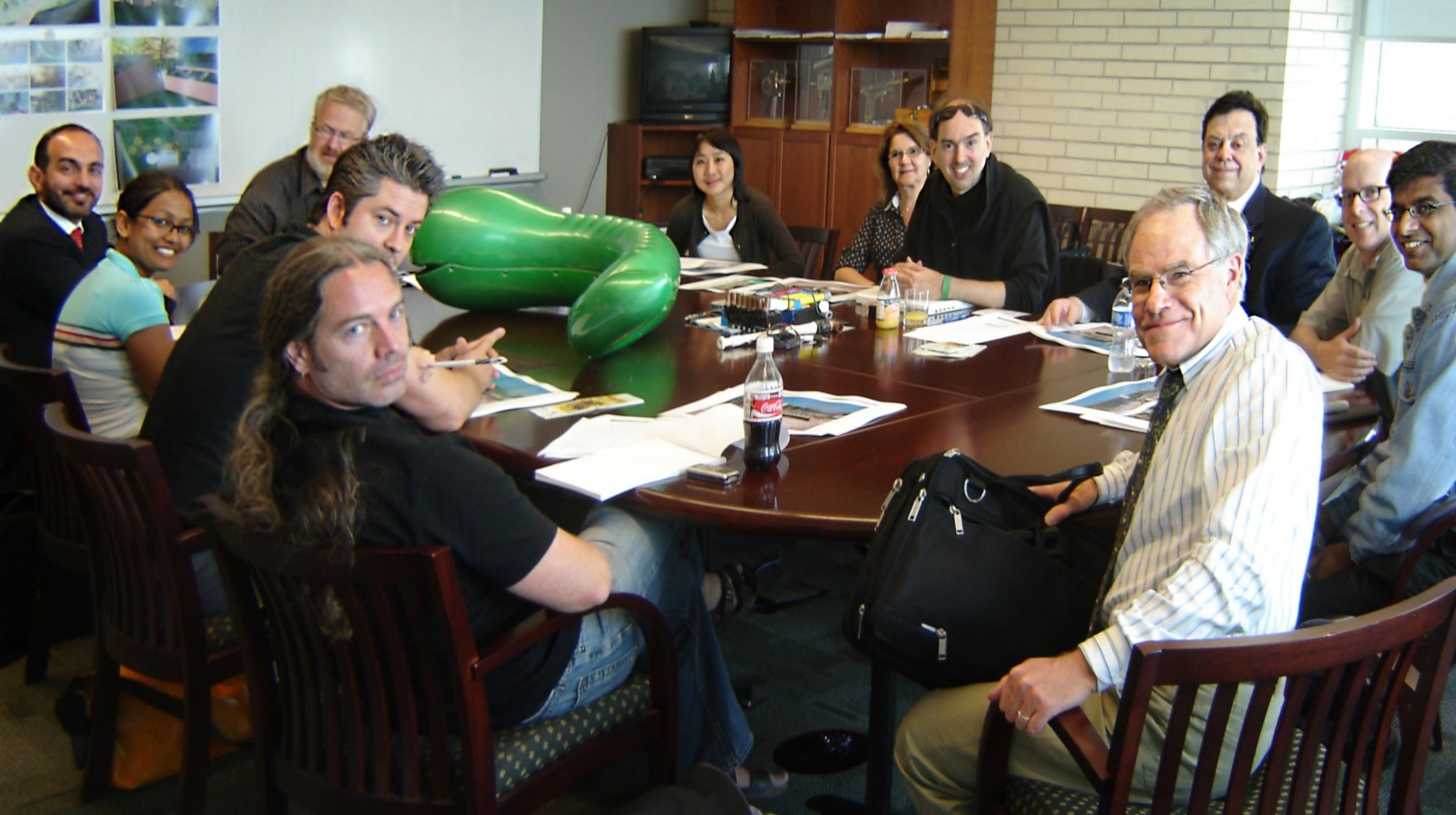Thanks to all who helped, including Georgina for help with organizing
the room booking and local arrangements.
Interpassionary meeting, 2007 July 5th, 3pm, BA8256

Clockwise, around the table, starting from the Coke bottle in the center
of the picture:
- A, Steve Daniels, Program Director,
New Media Option, School of Image Arts, Ryerson, University;
- B, Brent Cordner, Faculty of Architecture,
Landscape and Design, University of Toronto;
- C, Katrina Ramnarase, Child Study program, Ryerson University
(also Staff at the Ontario Science Centre);
- D, Alex Jadad, Director, Global eHealth, University
of Toronto
- E, Brian Cantwell Smith, Dean, Faculty of Information
Studies, University of Toronto;
- F, Adam Vaughan, represented here by Jennifer Chan,
City Councillor, City of Toronto;
- G, Cristina Amon, Dean, Faculty of Applied Science and
Engineering, University of Toronto;
- a, Steve Mann, Department of Electrical and Computer
Engineering, University of Toronto;
- b, Anastasios Venetsanopoulos, Vice President, Research,
Ryerson University;
- c, Jason Nolan, Early Childhood Education, Ryerson
University;
- d, Sandeep Kumar Agrawal,
school of urban and regional planning, Ryerson University.
- e, Bruce Kidd, Dean, Faculty of Physical Education and
Health.
Notes:
BCS: every great idea lives out its dying days as a platitude
Steve: Perhaps this could be said to apply to "New Media" or "Digital", etc.,
"Media" and "Digital" are getting "tired" (background rather than foreground).
in the post-digital/post-cyborg era; need for "fluid media" and
"primal media"; fundamental media and "non-media".
Nonmedia is existential activity: causes interaction simply by being
(e.g. cyborglog).
Sandeep, GIS, Ryerson, suggested we talk to Bruce Kuwabara.
Tas Venetsanopoulos: Arts consortium between Ryerson and OCAD.
Suggested not limit ourselves to only "research": include "creative activity".
given $5 million; establish centre for interdisciplinary...
interested in artistic side;
fashion department working on smart clothes (wearable computing).
Kerr Hall quad renovations; close Gould street, open up to community;
demolish tall building.
Bruce Kidd: consider Philosopher's Walk and/or Tattle Creek Road
Steve Daniels, Ryerson: suggested guerrilla approach to waterfront
Steve: Perhaps situationist-type interventions (art), "watervention"?
Presently there is no playing with water on the waterfront.
We're also trying to move beyond "guerrilla" approach toward more
well-funded and permanent installations/platforms.
Bret Cordner, UT Architecture, Biomimicry.
suggested that everyone thinks of and likes Millennium Park in Chicago.
suggested hydroforming of hydraulophone sculptures.
Brian Cantwell Smith (dean for 361 more days): suggested we use call it "site".
(I didn't quite catch the advantages of contextualizing it as a "site";
Brian, can you email a brief one or 2 sentence explanation?
Alex Jadad: supportive care (music+water therapy);
suggested we contact Bill Hutchison, who chairs the Toronto Waterfront
Revitalization Corporation's iWaterfront initiative aimed at turning the
Toronto Waterfront into an ``intelligent waterfront''.
Katrina: outlined some richly diverse cultural anecdotes around OSC
hydraulophone. Wondering how to explain hydr to kids (what do handwheels do?)
Overall, there was a feeling that we should not call it "research",
or "interdisciplinary" at least too broadly (outside organizations like
NSERC). I didn't quite catch the advantages of not calling it research
or not calling it interdisciplinary. Can anyone elaborate? Is it perhaps
simply a matter that we'd want to under-promise and over-deliver
(i.e. don't promise research as an outcome of this work)?
Is this perhaps also because it sounds too "academic"?
